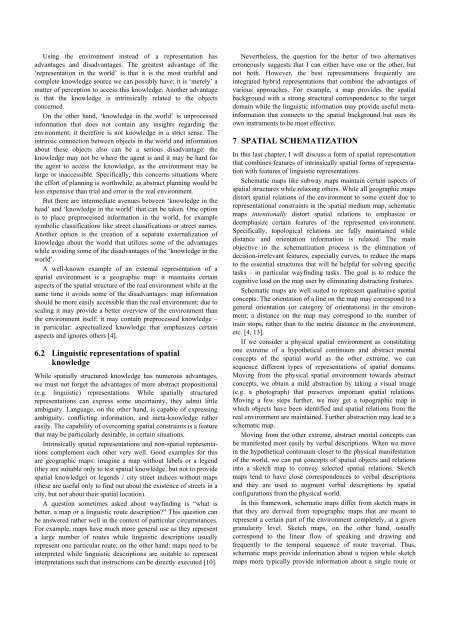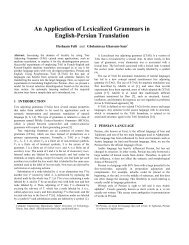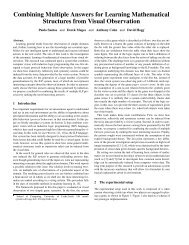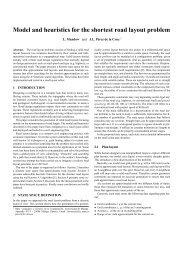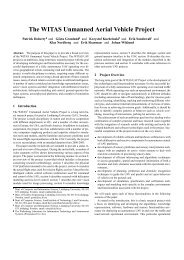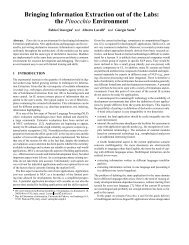Spatial Cognition - Frontiers in Artificial Intelligence and Applications ...
Spatial Cognition - Frontiers in Artificial Intelligence and Applications ...
Spatial Cognition - Frontiers in Artificial Intelligence and Applications ...
You also want an ePaper? Increase the reach of your titles
YUMPU automatically turns print PDFs into web optimized ePapers that Google loves.
Us<strong>in</strong>g the environment <strong>in</strong>stead of a representation hasadvantages <strong>and</strong> disadvantages. The greatest advantage of the‘representation <strong>in</strong> the world’ is that it is the most truthful <strong>and</strong>complete knowledge source we can possibly have; it is ‘merely’ amatter of perception to access this knowledge. Another advantageis that the knowledge is <strong>in</strong>tr<strong>in</strong>sically related to the objectsconcerned.On the other h<strong>and</strong>, ‘knowledge <strong>in</strong> the world’ is unprocessed<strong>in</strong>formation that does not conta<strong>in</strong> any <strong>in</strong>sights regard<strong>in</strong>g theenvironment; it therefore is not knowledge <strong>in</strong> a strict sense. The<strong>in</strong>tr<strong>in</strong>sic connection between objects <strong>in</strong> the world <strong>and</strong> <strong>in</strong>formationabout these objects also can be a serious disadvantage: theknowledge may not be where the agent is <strong>and</strong> it may be hard forthe agent to access the knowledge, as the environment may belarge or <strong>in</strong>accessible. Specifically, this concerns situations wherethe effort of plann<strong>in</strong>g is worthwhile, as abstract plann<strong>in</strong>g would beless expensive than trial <strong>and</strong> error <strong>in</strong> the real environment.But there are <strong>in</strong>termediate avenues between ‘knowledge <strong>in</strong> thehead’ <strong>and</strong> ‘knowledge <strong>in</strong> the world’ that can be taken. One optionis to place preprocessed <strong>in</strong>formation <strong>in</strong> the world, for examplesymbolic classifications like street classifications or street names.Another option is the creation of a separate externalization ofknowledge about the world that utilizes some of the advantageswhile avoid<strong>in</strong>g some of the disadvantages of the ‘knowledge <strong>in</strong> theworld’.A well-known example of an external representation of aspatial environment is a geographic map: it ma<strong>in</strong>ta<strong>in</strong>s certa<strong>in</strong>aspects of the spatial structure of the real environment while at thesame time it avoids some of the disadvantages: map <strong>in</strong>formationshould be more easily accessible than the real environment; due toscal<strong>in</strong>g it may provide a better overview of the environment thanthe environment itself; it may conta<strong>in</strong> preprocessed knowledge –<strong>in</strong> particular: aspectualized knowledge that emphasizes certa<strong>in</strong>aspects <strong>and</strong> ignores others [4].6.2 L<strong>in</strong>guistic representations of spatialknowledgeWhile spatially structured knowledge has numerous advantages,we must not forget the advantages of more abstract propositional(e.g. l<strong>in</strong>guistic) representations. While spatially structuredrepresentations can express some uncerta<strong>in</strong>ty, they admit littleambiguity. Language, on the other h<strong>and</strong>, is capable of express<strong>in</strong>gambiguity, conflict<strong>in</strong>g <strong>in</strong>formation, <strong>and</strong> meta-knowledge rathereasily. The capability of overcom<strong>in</strong>g spatial constra<strong>in</strong>ts is a featurethat may be particularly desirable, <strong>in</strong> certa<strong>in</strong> situations.Intr<strong>in</strong>sically spatial representations <strong>and</strong> non-spatial representationscomplement each other very well. Good examples for thisare geographic maps: imag<strong>in</strong>e a map without labels or a legend(they are suitable only to test spatial knowledge, but not to providespatial knowledge) or legends / city street <strong>in</strong>dices without maps(these are useful only to f<strong>in</strong>d out about the existence of streets <strong>in</strong> acity, but not about their spatial location).A question sometimes asked about wayf<strong>in</strong>d<strong>in</strong>g is “what isbetter, a map or a l<strong>in</strong>guistic route description?” This question canbe answered rather well <strong>in</strong> the context of particular circumstances.For example, maps have much more general use as they representa large number of routes while l<strong>in</strong>guistic descriptions usuallyrepresent one particular route; on the other h<strong>and</strong>: maps need to be<strong>in</strong>terpreted while l<strong>in</strong>guistic descriptions are suitable to represent<strong>in</strong>terpretations such that <strong>in</strong>structions can be directly executed [10].Nevertheless, the question for the better of two alternativeserroneously suggests that I can either have one or the other, butnot both. However, the best representations frequently are<strong>in</strong>tegrated hybrid representations that comb<strong>in</strong>e the advantages ofvarious approaches. For example, a map provides the spatialbackground with a strong structural correspondence to the targetdoma<strong>in</strong> while the l<strong>in</strong>guistic <strong>in</strong>formation may provide useful meta<strong>in</strong>formationthat connects to the spatial background but uses itsown <strong>in</strong>struments to be most effective.7 SPATIAL SCHEMATIZATIONIn this last chapter, I will discuss a form of spatial representationthat comb<strong>in</strong>es features of <strong>in</strong>tr<strong>in</strong>sically spatial forms of representationwith features of l<strong>in</strong>guistic representations.Schematic maps like subway maps ma<strong>in</strong>ta<strong>in</strong> certa<strong>in</strong> aspects ofspatial structures while relax<strong>in</strong>g others. While all geographic mapsdistort spatial relations of the environment to some extent due torepresentational constra<strong>in</strong>ts <strong>in</strong> the spatial medium map, schematicmaps <strong>in</strong>tentionally distort spatial relations to emphasize ordeemphasize certa<strong>in</strong> features of the represented environment.Specifically, topological relations are fully ma<strong>in</strong>ta<strong>in</strong>ed whiledistance <strong>and</strong> orientation <strong>in</strong>formation is relaxed. The ma<strong>in</strong>objective <strong>in</strong> the schematization process is the elim<strong>in</strong>ation ofdecision-irrelevant features, especially curves, to reduce the mapsto the essential structures that will be helpful for solv<strong>in</strong>g specifictasks – <strong>in</strong> particular wayf<strong>in</strong>d<strong>in</strong>g tasks. The goal is to reduce thecognitive load on the map user by elim<strong>in</strong>at<strong>in</strong>g distract<strong>in</strong>g features.Schematic maps are well suited to represent qualitative spatialconcepts. The orientation of a l<strong>in</strong>e on the map may correspond to ageneral orientation (or category of orientations) <strong>in</strong> the environment;a distance on the map may correspond to the number oftra<strong>in</strong> stops, rather than to the metric distance <strong>in</strong> the environment,etc. [4, 13].If we consider a physical spatial environment as constitut<strong>in</strong>gone extreme of a hypothetical cont<strong>in</strong>uum <strong>and</strong> abstract mentalconcepts of the spatial world as the other extreme, we cansequence different types of representations of spatial doma<strong>in</strong>s.Mov<strong>in</strong>g from the physical spatial environment towards abstractconcepts, we obta<strong>in</strong> a mild abstraction by tak<strong>in</strong>g a visual image(e.g. a photograph) that preserves important spatial relations.Mov<strong>in</strong>g a few steps further, we may get a topographic map <strong>in</strong>which objects have been identified <strong>and</strong> spatial relations from thereal environment are ma<strong>in</strong>ta<strong>in</strong>ed. Further abstraction may lead to aschematic map.Mov<strong>in</strong>g from the other extreme, abstract mental concepts canbe manifested most easily by verbal descriptions. When we move<strong>in</strong> the hypothetical cont<strong>in</strong>uum closer to the physical manifestationof the world, we can put concepts of spatial objects <strong>and</strong> relations<strong>in</strong>to a sketch map to convey selected spatial relations. Sketchmaps tend to have close correspondences to verbal descriptions<strong>and</strong> they are used to augment verbal descriptions by spatialconfigurations from the physical world.In this framework, schematic maps differ from sketch maps <strong>in</strong>that they are derived from topographic maps that are meant torepresent a certa<strong>in</strong> part of the environment completely, at a givengranularity level. Sketch maps, on the other h<strong>and</strong>, usuallycorrespond to the l<strong>in</strong>ear flow of speak<strong>in</strong>g <strong>and</strong> draw<strong>in</strong>g <strong>and</strong>frequently to the temporal sequence of route traversal. Thus,schematic maps provide <strong>in</strong>formation about a region while sketchmaps more typically provide <strong>in</strong>formation about a s<strong>in</strong>gle route or


